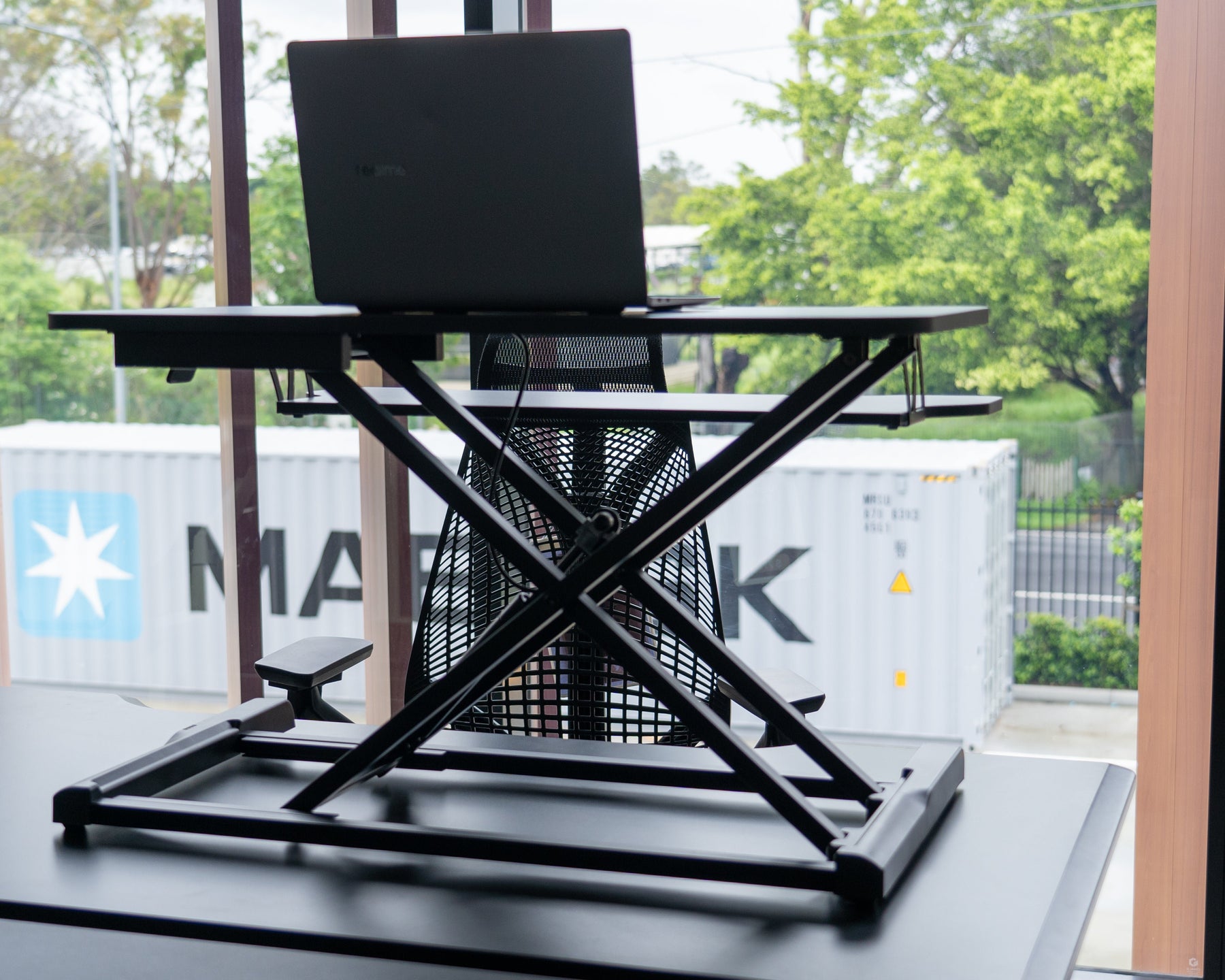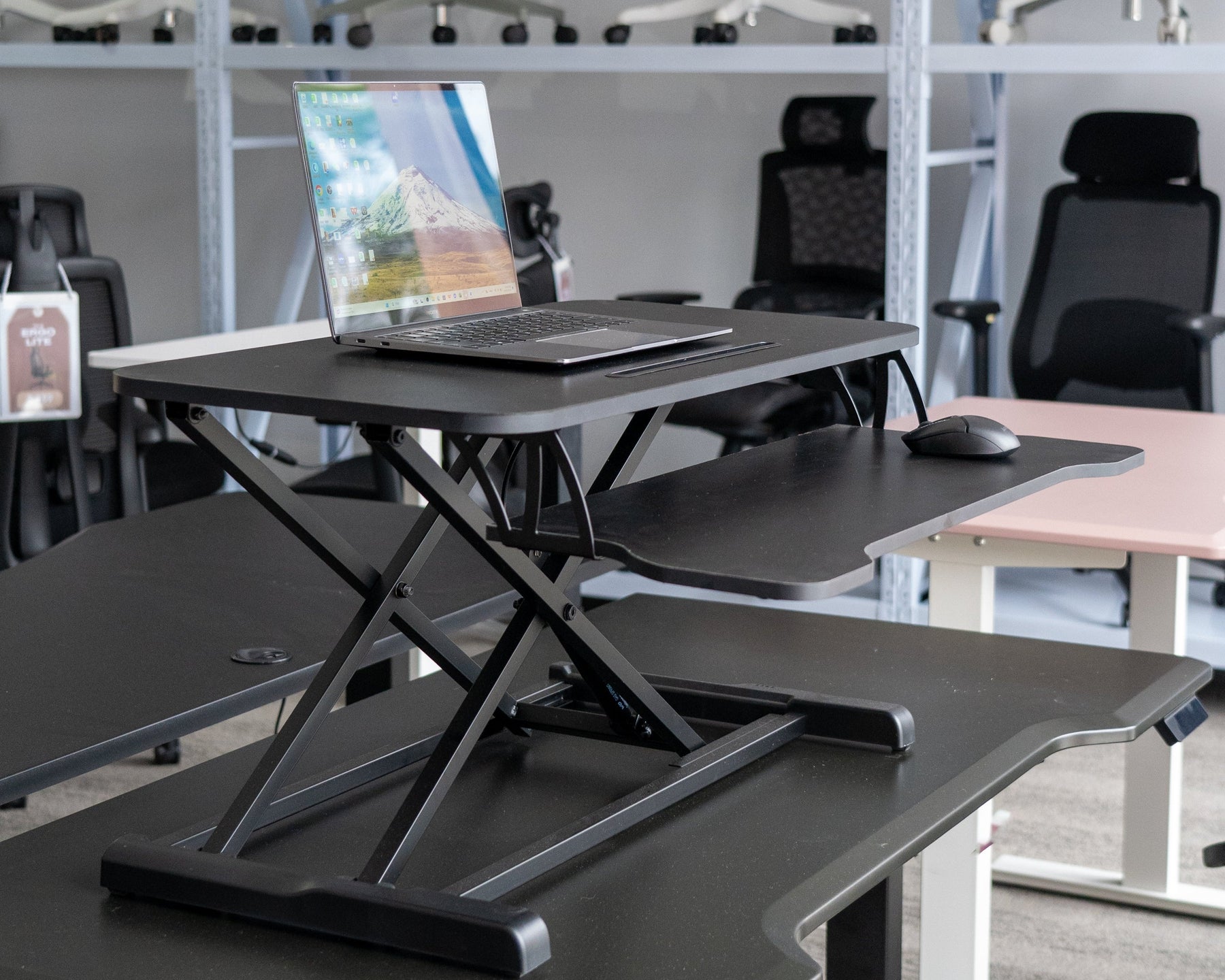Is It Healthy to Stand All Day at a Standing Desk?
Introduction: The Rise of Standing Desks
With the shift toward healthier workplaces, standing desks have become a popular choice among professionals looking to avoid the pitfalls of prolonged sitting. But is it healthy to stand all day at a standing desk? The answer lies in striking a balance between sitting, standing, and moving throughout the workday.
This article will explore the health benefits and risks of standing desks, how to use them effectively, and why the Desk One Height Adjustable Sit-Stand Desk Riser might be your perfect ergonomic solution.

Health Benefits of Standing Desks
2.1 Improved Posture and Spine Health
- Standing desks encourage users to maintain a neutral spine position, reducing slouching and back pain.
- A properly adjusted desk can alleviate strain on the neck and shoulders.
2.2 Boosted Energy Levels and Productivity
- Alternating between sitting and standing improves blood circulation, keeping you energized throughout the day.
- Standing while working can enhance focus and reduce feelings of fatigue.
2.3 Reduced Risk of Chronic Diseases
- Studies show that standing intermittently lowers the risk of obesity, heart disease, and type 2 diabetes.
- Improved insulin response from standing helps regulate blood sugar levels.
The Risks of Standing All Day
3.1 Leg and Foot Strain
- Standing for extended periods can lead to swelling and discomfort in the legs and feet.
- Use anti-fatigue mats and supportive shoes to minimize strain.
3.2 Potential for Varicose Veins
- Prolonged standing can cause blood to pool in the legs, increasing the risk of varicose veins.
- Regular movement and leg stretches can help improve circulation.
3.3 Lower Back Pain
- Poor posture while standing can exacerbate lower back pain.
- Ensuring your desk is set to the correct height can reduce this risk.
Finding the Right Balance: Sit-Stand Ergonomics
The key to reaping the benefits of a standing desk is balance. Experts recommend alternating between sitting and standing every 30 to 60 minutes. Incorporating light movement and stretches can also help alleviate discomfort.
Introducing Desk One Height Adjustable Sit-Stand Desk Riser

The Desk One Height Adjustable Sit-Stand Desk Riser is designed to support a healthier and more ergonomic work environment.
Key Features and Benefits
Adjustable Height Range:
- Lowest Position: 10mm
- Highest Position: 490mm
- Effortlessly switch between sitting and standing for personalized comfort.
Spacious Work Surface:
- Top Platform: 800mm x 400mm
- Room for a laptop, monitor, and accessories.
Ergonomic Keyboard Tray:
- Tray Dimensions: 700mm x 300mm
- Promotes comfortable typing and reduces wrist strain.
Sturdy Construction:
- Supports up to 15kg, ensuring stability for office devices.
Compact and Portable:
- Lightweight yet durable, ideal for any workspace.
Tips for Using a Standing Desk Effectively
6.1 Set Proper Height Levels
- Adjust your desk so your elbows are at a 90-degree angle when typing.
- Ensure your screen is at eye level to avoid neck strain.
6.2 Alternate Between Sitting and Standing
- Stand for 20-30 minutes for every hour of sitting.
- Use a timer to remind yourself to switch positions.
6.3 Incorporate Movement Breaks
- Take short walks or stretch to improve circulation.
- Simple leg exercises can prevent stiffness and fatigue.
FAQs About Standing Desks
1. How long should I stand at my desk each day?
Experts recommend standing for 15-30 minutes every hour and alternating between sitting and standing to avoid strain.
2. Are standing desks suitable for everyone?
Yes, but individuals with specific health conditions, such as joint problems, should consult a professional before using one.
3. Can standing desks help with weight loss?
Standing burns slightly more calories than sitting, but significant weight loss requires additional physical activity.
Comparison Table: Sitting vs. Standing
| Feature | Sitting | Standing |
|---|---|---|
| Calorie Burn | Low | Slightly higher |
| Posture | Increased slouching risk | Promotes better posture |
| Energy Levels | Decreased over long periods | Boosted with intermittent standing |
| Risk of Chronic Diseases | Higher due to inactivity | Lower with balanced movement |
Ad Insert
Desk One Height Adjustable Sit-Stand Desk Riser: Optimize your workspace and health with our ergonomically designed sit-stand desk riser. Effortlessly switch between sitting and standing to stay active and comfortable throughout the workday. Durable, portable, and built to last—your ideal work companion!

